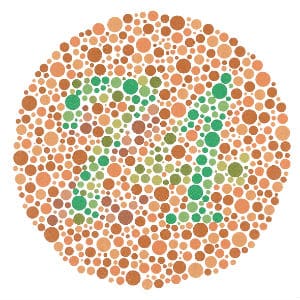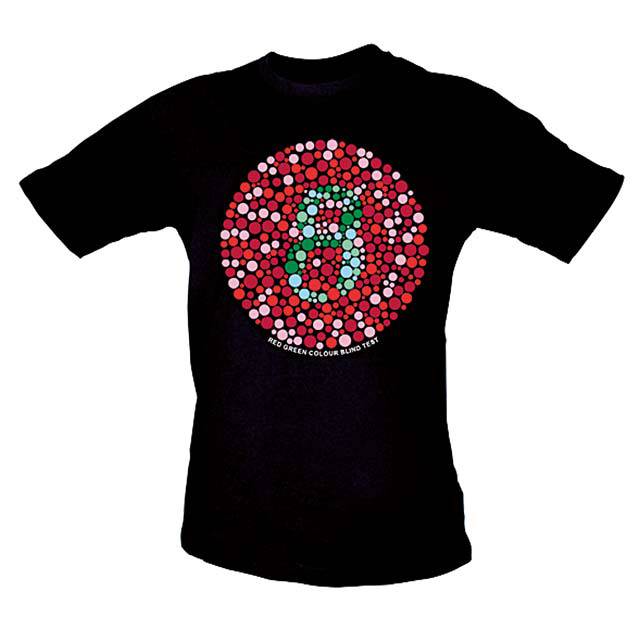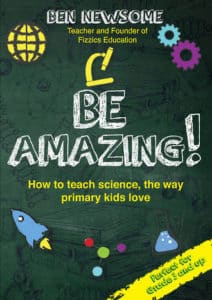
Just one of the many Ishihara Colour blindness tests
Image: Wikipedia
Many people are aware of the variety of colour blindness tests available that are based on the Ishihara Colour blindness tests plates developed by Dr Shinobu Ishihara in 1917. Often seen as the ‘dot test’, people can get an idea of how well they see colours by running themselves through a series of quick tests in which they need to pick out the numbers and patterns depicted. The thing is, how often does the inability to perceive colours get picked up in class? Does it really have an impact on education, or is it just an oddity? As I myself have a form of red-green colour blindness, I thought I might dive deeper into this from a personal perspective as well as from a science educators point of view.
Only recently I was at school running a human body science incursion and the topic of vision & colour blindness was clearly a major interest with the students. They were in the middle of a unit covering the 5 senses and as I personally have red-green colour blindness, the kids were very interested trying to understand what I see when exposed to same frequencies of light as themselves. As the majority of the population sees the spectrum from red to violet, it is difficult for students to understand how colour perception can be different between people. Being a science teacher I couldn’t help myself but use my condition to my advantage, namely delving into the issue with real-life examples and how it actually works.
Do both sides of the photo seem the same colour? Perhaps this might indicate colour deficiency.
Image: Enchroma

There are several types of colour blindness. My specific type of colour blindness is called deuteranomaly, which basically means that my retina at the back of my eye will not pick up much green light and instead is quite sensitive to reds, yellows and oranges. This means that greens, reds, yellows, oranges and browns all can all look quite similar to me, especially when it is dim. It also means that some blues and purples look similar as does some pinks and greys. Basically, the cone-shaped structures within my retina have defective photopigments and as such don’t pick up light frequencies in the same way that the most of the population does. It’s a sex-linked condition, in that the photopigment production genes are carried on the X chromosome and males only get one of those whereas females get both, causing males to show the condition more often (only one gene needs to be functional for normal colour vision to result).
You could imagine that once students find out that I’m colour blind, invariably they can’t help but want to point out colours around the room in the hope to hear a strange answer … yet most of the time only to be disappointed as I keep naming most colours perfectly! You see, it is a standard misconception of students that all colour-blindness is alike and that we see things in ‘black and white’ (this condition whilst does exist is extremely rare!). At this point, they’re understandably confused as the students expected a completely different answer. The reality is that 5 out of 100 males and 1 out of 100 females have my version of colour blindness and we generally lead quite normal lives, in that it’s not so much a complete lack of colour perception rather it’s more just a difficulty in determining various hues.
But what does this mean for the practising teacher? Well, perhaps it’s time to consider running one of these colour blind tests with your students. Lets be up front: we’re not doctors and are not qualified to make a medical diagnosis… however, if you find that students clearly cannot read certain numbers in the Ishihara colour blindness tests it would be high recommended that you at least let the student know and from there decide if the student is happy letting their parent’s know. Perhaps it might also change some of the ways you present visual information too. Why? Well, you’d be surprised how it might be impacting your students. Here’s just a couple of examples:
I can distinctly remember sitting in class during primary school whereby often the only chalk left in the room was a dull pink colour. Using this on an old blackboard (which is really a dull green) made it very difficult to read anything. Unfortunately, at the time I had to just squint and write down what I could, often to the detriment of my work. To this day I still see noted speakers at conferences who have placed red writing on a green background in a PowerPoint presentation… without realising that they’re making it really hard for some of their audience to read their words.
In high school, we had to run chemical titrations using methyl red indicator. For normal colour vision student this was not an issue but for me, I couldn’t see the distinct change between red to orange to yellow in different pH solutions, thereby completely missing the end point of the titration. This meant that when I had to enter in the volumes measured I was always completely out. It wasn’t a real issue in high school as generally we worked in student pairs however in University it was a problem as the chemistry practical exam involved this same indicator… a bit of an issue!

Methyl red changing colour in acidic to alkaline conditions (left to right)
Image – Wikipedia
This only just a couple of examples but they’re there to underline the point that students in your classroom just may not be perceiving what you think they are. Of course, it extends to future employment prospects as in many jurisdictions colour blind people are restricted from becoming pilots, electricians and certain defence jobs. Even if people with colour blindness aren’t excluded it can still hinder their work; imagine being a graphic designer working on a website, a painter or interior designer, a doctor diagnosing the degree of inflammation or working as a pathologist trying to determine colour stains in histology! It’s due to this that as a careers advisor or high school you need to know who might have a colour blindness condition in your student cohort. If you’re involved in the school executive it might be worth considering some in-house training for your teachers on how to handle this, as although it may not seem that it doesn’t impact day to day teaching it actually could be and your staff may not even be aware of it.
The recent development of Enchroma glasses technology is interesting in that in some cases it may help to reduce the impact of colour blindness. There is some clinical evidence to support the claims and it could be very exciting for people with whom it has a positive effect! I personally have not tried the glasses out but they sound interesting. Quickly, for full disclosure I have nothing to do with the company nor any of their staff or even any of their customers… it just sounds like a cool technology that could be worth checking out.
You can also check out this Australian Colour Blindness Support Group too!
Some extra reading (copies held by National library):
-
Understanding colour blindness : can you see what I see / Dennis R. Overton
- I see red when you see green / Dennis R. Overton
For a bit of fun, we do stock a colour blindness shirt. By the way, I can read the number but there would be people who wouldn’t be able to see the number clearly if at all.
Colour blindness shirt

So with all this in mind, it would be well worth you considering to trial some colour vision tests with your students. Even if none of your students turns out to have a condition, it would be a great talking point about the diversity of our genetic heritage, how sex-linked conditions work plus it opens up a dialogue to discuss other conditions that impact people around the world (eg. Hemophilia & Duchenne Muscular Dystrophy). Just be sure to be sensitive in how you go about introducing the topic, how you introduce the test and how you inform the student or family. After all, whilst in many ways most colour blindness doesn’t impact greatly on most kids lives, it still is a condition that your student might be sensitive about – especially in the public arena that is your classroom.
Happy teaching,
NEW Primary science teaching book!
“Be Amazing! How to teach science, the way primary kids love”



























Colour blindness in the classroom is a very great write-up and excellent information. Thank you for sharing all information. And here is also a collection of facts about color blindness so visit this.